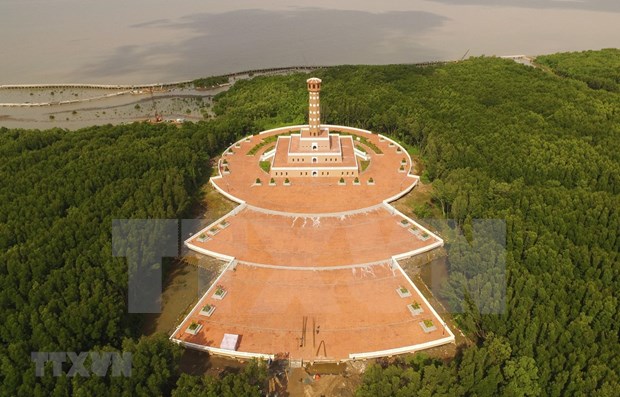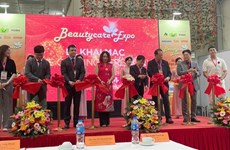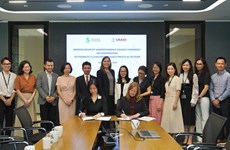Ca Mau province focuses on tourism development
Ca Mau (VNA) – The southernmost province of Ca Mau is focusing all resources on tourism development in a bid to become a tourist hub in the Mekong Delta region.
The tourism development linkage between Ca Mau province and other Mekong Delta localities and provinces of Thailand and Cambodia located on the southern coastal corridor is very important.
 The Hanoi flagpole in Ca Mau Cape will be an important highlight to promote the development of local tourism in the future. (Photo: VNA)
The Hanoi flagpole in Ca Mau Cape will be an important highlight to promote the development of local tourism in the future. (Photo: VNA)Located in the southernmost part of the country and on the southern economic development corridor of the Greater Mekong Subregion (GMS) Development Cooperation Programme, Ca Mau has favorable conditions for economic development exchanges with other countries in Southeast Asia. Therefore, cooperation and integration are very important strategies for Ca Mau’s tourism.
The province has implemented many mechanisms and policies to invite and support investors and businesses operating in the tourism industry. A series of significant tourist works have just been built, such as Ca Mau Cape with the end of Ho Chi Minh Road, Ca Mau Cape Flagpole, Lac Long Quan Temple, and Mother Statue.
Solving traffic connection problem
Facing the end of globalization and regionalization, to develop tourism, Ca Mau needs to acquire and share experience, and enhance cooperation between state management agencies and enterprises operating in the tourism sector.
Investment in developing the transport infrastructure system connecting tourist areas and destinations, forming experience tours, improving tourism products, attracting travel businesses and building many quality hotels has made a drastic change in the province’s tourism development. However, the locality still sees many limitations in transportation.
“Thais want to visit and experience ecotourism as well as enjoy the typical foods of Ca Mau, especially Ca Mau crab and shrimp. Ca Mau tourism has not yet attracted international tourists because of poor transport infrastructure. For example, if I want to go to Ca Mau, I have to fly from Thailand to Ho Chi Minh City and then take a car for many hours to reach Ca Mau. It takes much time and money'', said Peerapol Triyakasem, President of Virgo Solution Tourism Company of Thailand.
To lure more foreign tourists, Ca Mau needs to pay attention to developing road, sea and air transport synchronously, he said, adding that the province should develop marine tourism as the costs are much cheaper than air travel.
Boasting many fishing ports and estuaries, the province needs to invest in upgrading and developing attractive tourist destinations of international stature and connect tourism between Ca Mau, Thailand and Cambodia, he said.
According to Director of the Vong Tron Viet Tourism Company Phan Dinh Hue, a Mekong Delta tourism development consultant, said that Ca Mau will cooperate with shipping lines to open routes linking Phu Quoc and Cambodia and Thailand by 2025 and after that with other countries in the region.
Ca Mau is now interested in promoting tourism development connection with localities in the Mekong Delta, Ho Chi Minh City and Hanoi as well as Trat province (Thailand), Khammouane province (Laos) and Koh Kong province (Cambodia).
The province has sought the Government’s approval for its investment in expanding Ca Mau airport and Hon Khoai seaport to boost socio-economic development and attract domestic and international tourists.
 Ecotourism is an important highlight to attract tourists to Ca Mau Cape. (Photo: VNA)
Ecotourism is an important highlight to attract tourists to Ca Mau Cape. (Photo: VNA)Great advantages for ecotourism development
According to the Vice Chairman of the provincial People's Committee, Tran Hong Quan, the locality boasts unique cultural features and gathers many factors to develop different types of tourism such as island and sea tourism, geographic tourism, ecotourism, leisure tourism and cultural-festival tourism.
Defining sustainable tourism development, the province is calling for investment in tourism development in the direction of tapping potential to make ecotourism an important service industry.
Tourism infrastructure in Ca Mau has gradually improved. The province takes the Ca Mau Cape National Park Tourism Area and the U Minh Ha National Park Tourism Area as highlights for local tourism.
Ca Mau is one of the four key economic provinces and cities of the Mekong Delta as it has the largest fishing ground in Vietnam and boasts the potential and strengths for developing marine economy, aquaculture and ecotourism with over 100,000 ha of cajuput and mangrove forests recognized by UNESCO as the World Biosphere Reserve and World Ramsar Site.
In addition, Ca Mau province has three sides bordering the sea, with 254km of coastline and many islands such as Hon Khoai, Hon Chuoi, Hon Da Bac.
At the same time, the province's catches are about 600,000 tonnes a year, including 210,000 tonnes of shrimp. The culinary advantage offers the province a chance to attract visitors./.













